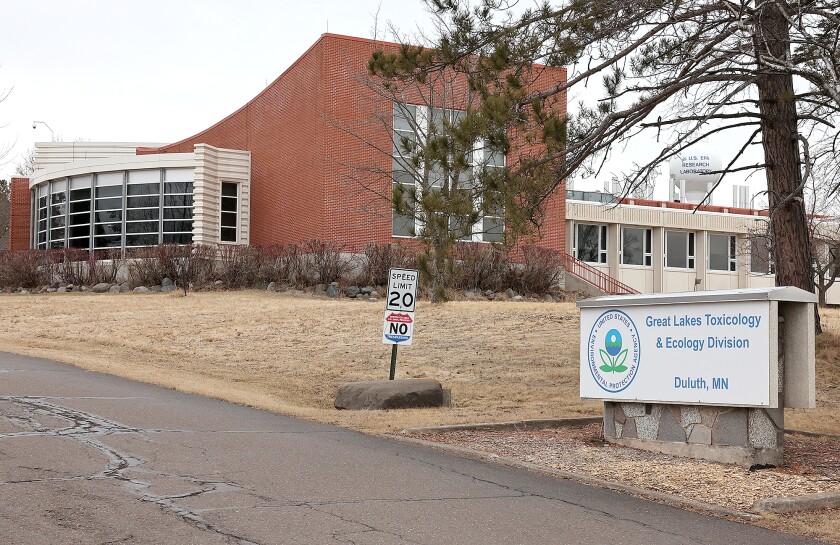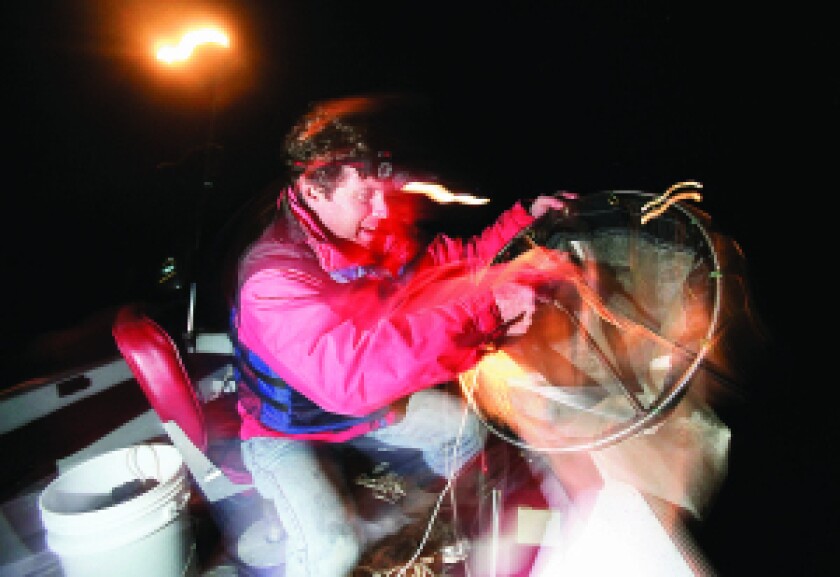DULUTH — Approximately two dozen early-career researchers have been forced out of the U.S. Environmental Protection Agency’s laboratory over the last month when the Trump administration cut a grant and didn't renew a contract to fund their programs.
Meanwhile, the lab’s federal employees — like other EPA employees throughout the agency — have been given the option to retire early, leave voluntarily or apply for a limited number of jobs at other divisions within the agency.
ADVERTISEMENT
More than two months after the Trump administration’s plans to cut the EPA’s Office of Research and Development uncertainty still swirls around the future of EPA’s Great Lakes Toxicology and Ecology Division Laboratory, 6201 Congdon Blvd., which is part of ORD.
A portion of the reduction plan, by Science Committee Democratic staff, said the EPA planned to “eliminate” the ORD and expected 50%-75% of its more than 1,540 positions "will not be retained."
Earlier this month, the Trump administration which called for a $235 million, or 45%, cut in ORD’s budget.

According to multiple sources familiar with the matter, and a recording of a May 2 virtual meeting obtained by the News Tribune, EPA officials told ORD employees that they could apply to approximately 500 job openings at other offices within the EPA.
Job applications for the new positions and decisions on early retirement or the so-called deferred resignation program were all due a week later, on May 9.
Questions about relocation for the new jobs, however, linger. While one official said the 130 new jobs within the Office of Chemical Safety and Pollution Prevention would not require relocation and gave Duluth as an example of a place the staffer could remain, a slide showing the organization the newly created Office of Applied Sciences and Environmental Solutions, which account for 300 of the new jobs, only listed locations in Oklahoma, Ohio, North Carolina and Washington, D.C.
Officials said another 30-50 positions would be available at the Office of Air and Radiation and told staff at ORD they could also apply for new positions in the Office of Water.
ADVERTISEMENT
Questions on the future of ORD were often answered by officials who said the latest plans didn’t directly affect ORD and that more reorganization plans were coming.
Less than a week later, as the May 9 deadline loomed, ORD staff were told, “If you’re interested in remaining with the Agency, we encourage you to apply for any and all of the positions you may be qualified for,” according to an email reviewed by the News Tribune.

Send a confidential news tip. You will remain anonymous unless you agree to go on the record.
Using a personal device, you can contact reporter Jimmy Lovrien by:
- Email: jlovrien@duluthnews.com
- Call or text: 218-461-9718
- (a secure, encrypting messaging application. Read more about it ):
- Postal mail: Duluth News Tribune, c/o Jimmy Lovrien, P.O. Box 16046, Duluth, MN 55816
However, any mass layoffs appear to be on hold after the Trump administration from large-scale reductions in force or agency reorganizations of federal agencies, including the EPA, “without partnering with Congress.”
Even so, the lab’s workforce has dropped by about 25 over the last month when a grant was cut and a contract left to expire, both of which allowed early-career researchers to work alongside EPA scientists at the lab. Prior to that, there were 176 employees at the lab, 68 of whom were federal scientists, and the remaining 108 were post-doctoral researchers, student contractors and facility staff, according to an updated in April.
It’s unclear how many employees took an early retirement or deferred resignation.
In response to the News Tribune’s request for an interview on what the agency’s reorganization effort and cancellation of the grant and contract meant for the future of the Duluth lab, an EPA spokesperson responded with a brief statement.
“At ORD (Office of Research and Development) and throughout the agency, EPA is continuing to invest in research and labs to advance the mission of protecting human health and the environment,” a spokesperson for the EPA said.
ADVERTISEMENT
Contract not renewed
A five-year National Student Services Contract between the EPA and Oak Ridge Associated Universities that allowed earlier career researchers to work alongside EPA scientists at expired May 14 and a new contract was not approved.
ORAU did not respond to the News Tribune’s request for comment. Multiple sources estimated that approximately 20 researchers, ranging from undergraduates to postdocs, at the Duluth Lab were let go when the contract expired. On its website, ORAU has removed employee spotlight pages that once highlighted the work of its researchers working with the EPA. It also replaced

“ORAU would like to thank EPA for 10 years of successful partnership managing the National Student Services Contract (NSSC),” the website said this week. “We would also like to thank all of our employees who worked side by side with the hardworking federal employees at EPA.“
DOGE, EPA cut UMD training grant
Last month, the EPA cut a $3.5 million grant that trained undergraduate and graduate students at the University of Minnesota Duluth in chemical risk management and water quality protection.
The grant began in November 2023 and was expected to last five years, but it ended abruptly April 30, with a notice from the EPA stating the grant was terminated immediately because the “objectives of the award are no longer consistent with EPA funding priorities,” a UMD spokesperson said.
More than $800,000 had been obligated when the grant was cut, with almost $300,000 already paid to the university, according to
The Department of Government Efficiency, President Donald Trump and billionaire Elon Musk’s effort to slash federal spending and programming, now lists the cutting of the grant as a savings on its so-called
ADVERTISEMENT
In a statement, professor of biology at UMD, said the school requested “an orderly closeout” so it can continue the contract until next spring.
“Water quality protection is of vital importance for Minnesotans and people across the country, and the EPA and UMD scientists have a long and productive track record of collaboration in research and student training,” Branstrator said. “Without this funding, the region and the nation will lose out on the training and career development of current and future scientists committed to protecting the environment.”

A UMD spokesperson said one postdoctoral investigator and four graduate students from UMD were in training when the grant was cut, and another two graduate students were expected to begin in the fall. The grant cut affects an additional 15 undergraduate students, seven graduate students and three postdoctoral investigators who would have been trained in aquatic toxicology and ecology.
Lawmakers seek answers
A by U.S. Sens. Amy Klobuchar and Tina Smith, both Democrats from Minnesota, to EPA Administrator Lee Zeldin demanding answers about the future of the Duluth lab has not been answered by the agency, Smith’s office said. The two sent a follow-up letter to Zeldin urging him to respond to their earlier letter and confirm the EPA would not attempt to reduce staff at the Duluth lab while the court's injunction on large-scale reductions in force and reorganizations is in effect.
In a statement Thursday, Smith said the lab in Duluth and its work on clean and safe water were irreplaceable because of its access to Lake Superior.
“I’m extremely concerned that workers at the lab aren’t getting the clarity they deserve about what’s going on. They are being left in the dark, not knowing if their jobs are safe,” Smith said. “The Trump administration needs to listen to the federal court order temporarily halting any proposed cuts to the lab, but unfortunately this administration has shown a blatant disregard for rule of law and court orders. I’m disappointed the Trump EPA can’t answer a series of simple questions about the future of the lab and these workers, but I’m not giving up.”
In a separate statement Thursday, Klobuchar echoed the need to keep the Duluth lab open.
ADVERTISEMENT
“The Duluth lab is critical for the Northland and the Great Lakes in a big way — ensuring safe drinking water and supporting our recreation and shipping economy — which is why I continue to press the administration to keep the lab open,” Klobuchar said.
“While the courts have stepped in to block these across-the-board changes, we must continue to protect our Northland and the Great Lakes," she said. "I support making the government more efficient, but it must be done in a way that is based on facts and science, without threatening our economy or putting public health on the line.”
State Sen. Grant Hauschild, DFL-Hermantown, also wrote a letter to Zeldin in April, but had not received a response as of Tuesday, a spokesperson for his office said.
U.S. Rep. Pete Stauber, R-Minn., said he recently met with EPA Region 5 Administrator Anne Vogel.
“Congressman Stauber did express his desire for the Duluth Research Lab to remain open due to the important research they perform around the Great Lakes," a spokesperson for the Hermantown lawmaker's office said Thursday. "There is no new update on the status of this lab, and Regional Administrator Vogel relayed to the congressman that this decision ultimately remains with EPA Administrator Lee Zeldin."













